Ancient Towns in Israel - Diocaesarea aka Sepphoris (Zippori) (original) (raw)
You may wish to see an introductory page to this section with a map first.
To be sure the greatest cities of Galilee o Justus! were Sepphoris and thy country Tiberias. But Sepphoris situated in the very midst of Galilee and having many villages about it and able with ease to have been bold and troublesome to the Romans if they had so pleased, yet did it resolve to continue faithful to those their masters and at the same time excluded me out of their city and prohibited all their citizens from joining with the Jews in the war.
Flavius Josephus - The Wars of the Jews - Translation by Samuel Burder
Josephus was the leader of the First Jewish Revolt in Galilee and in 67 AD he was captured by Roman general Vespasian who became emperor two years later. Josephus, who had prophesied the event, became an adviser to Titus, Vespasian's son, during the rest of the campaign. He was eventually freed and, consistent with Roman usage, he added the "surname" of his patrons (gens Flavia) to his name. He then wrote several books (in Greek) on the history of the Jews which were meant for a Roman audience, but nonetheless are the main source of information for historians and archaeologists on many events which occurred during the First Jewish Revolt and in the century which preceded it.
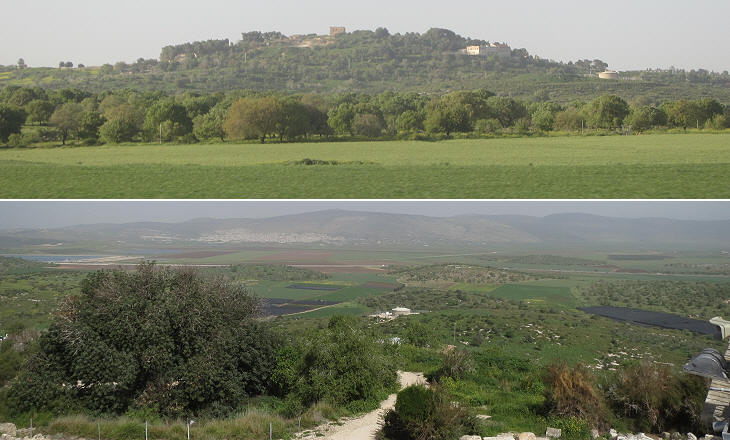
Views: (above) the upper town seen from the road between Tiberias and Haifa; (below) view from the upper town towards the said road which is located to its north
We rode as fast as possibly we could, until we got to the foot of the hill that leads up to Sephoury. We ascended the high hill, on which the antient city of Sephor or Sephoris stood, the strongest of all this country; it was made the capital of Galilee; an honour which before was enjoyed by Tiberias. This place was also called Diocesarea.
Richard Pococke - A Description of the East and Some Other Countries - 1745
The archaeological site of Sepphoris (eventually renamed Diocaesarea) is very conveniently located near a main road and a few miles from Nazareth, which is a "must see" of every tour of Galilee, yet it does not attract many visitors, notwithstanding its very fine Roman mosaic floors.
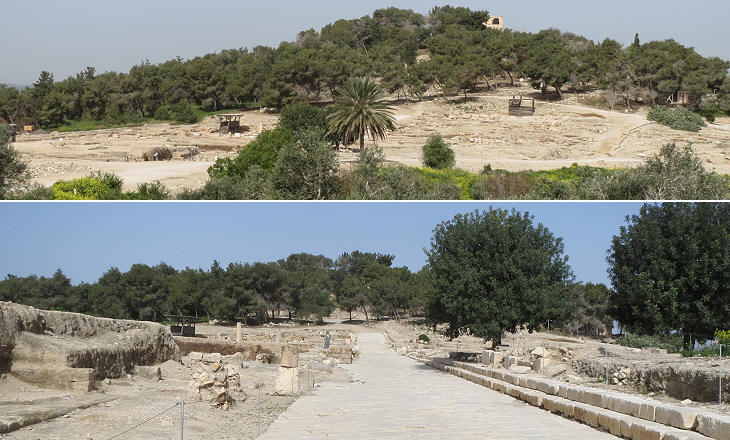
(above) Excavated area; (below) "Decumanus Maximus" the main east-west street
There is a castle on the top of the hill, with a fine tower of hewn stone; and near half a mile below it, is the village of Sephoury, called by the Christians Saint Anna, because they have a tradition, that Joachim and Anna, the parents of the blessed virgin, lived here, and that their house was on the spot where there are ruins of a church, with some fragments of pillars of grey granite about it. Pococke
Seffurieh - A large village of low houses of mud and stone, with flat mud roofs, grouped in a sort of crescent shape on the south slope of the hill. (..) The place is surrounded with olives. The ruins are of two kinds: those of the Roman period, tombs, sarcophagi, and the aqueduct; those of later times, the castle and the church.
Claude Reignier Conder - The survey of western Palestine - 1883
An Arab village which retained the name of the ancient town stood on the site of the acropolis until 1948 when its inhabitants were evicted and pine trees were planted where the village stood.
The very first excavations started in 1931, but not until the 1980s were they resumed.
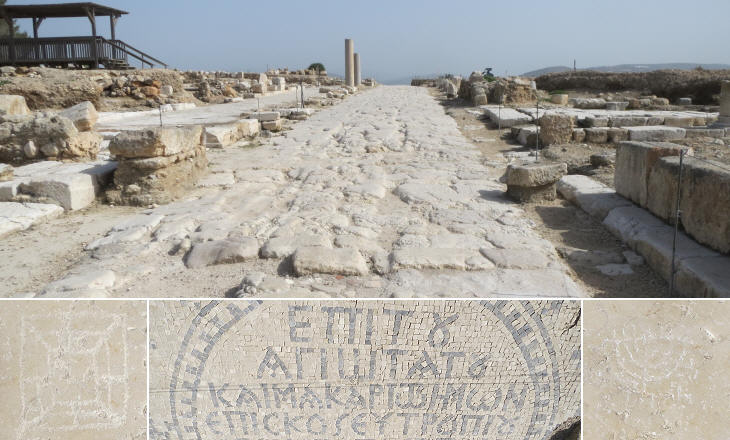
(above) Cardo Maximus, the main north-south street; (below-left) a betting game carved on one of the stones, similar to that of the Lithostrotos at Jerusalem; (below-centre) mosaic bearing an inscription celebrating the donor who built a portico along the street (a similar mosaic can be seen at Scythopolis); (below-right) a menorah carved on a stone
There are several broken stone coffins about the village. (..) The next morning, we set out for Nazareth: About a mile to the south east is the fine fountain of Sephoury, which probably is the fountain of this name, where the kings of Jerusalem, during the holy war, encamped their armies, on account of the great plenty of water and herbage, that there is about this place. Pococke
A mile to the south is Kus till Seffurieh, with the fine springs, where the army of the Christians encamped before the battle of Hattin. Conder
Often ancient towns were known by more than one name, but Sepphoris is a special case: Herod Antipas, son of Herod the Great, King of Judea, renamed it Autocratis, Vespasian called it Neronias, but the name was soon dropped because Emperor Nero was deposed by the Senate. Diocaesarea, the new Latin name, indicates that the town had a temple to Zeus as did Diocaesarea (Olba) in Turkey.

(left) Crusader fortress; (right-above) Mameluke portal; (right-below) sarcophagi
This town was fortified by Herod, but upon some insurrection of the Jews, it was destroyed in the time of Constantius. Pococke
The Castle situate on the hill-top, commands a view on all sides, and is a place of natural strength. (..) The whole tower is built of old materials, including drafted ashlar and sarcophagi. There is a sarcophagus built into the north-east corner, another into the south-west corner at the bottom, and another on the west wall north of the window. Conder
In 313 Emperor Constantine issued the Edict of Tolerance, by which he granted all citizens freedom in the exercise of religion. His son Constantius II favoured the Christians with the aim of achieving religious unity throughout the Empire. This caused frictions with the Jews who did not want to convert. In 351 the Jews of Diocaesarea caught the garrison by surprise and killed many Christians. Eventually the town was seized by a Roman army and its Jewish population was almost exterminated. This caused the decline of Diocaesarea which was struck by an earthquake in 363. The town does not appear in Tabula Peutingeriana, a Vth century map of the roads of the Roman Empire.
Sepphoris was conquered by the Crusaders in the XIth century. They built a small fortress at its top using materials from ancient buildings. It was eventually turned into a school for the children of the Arab village.
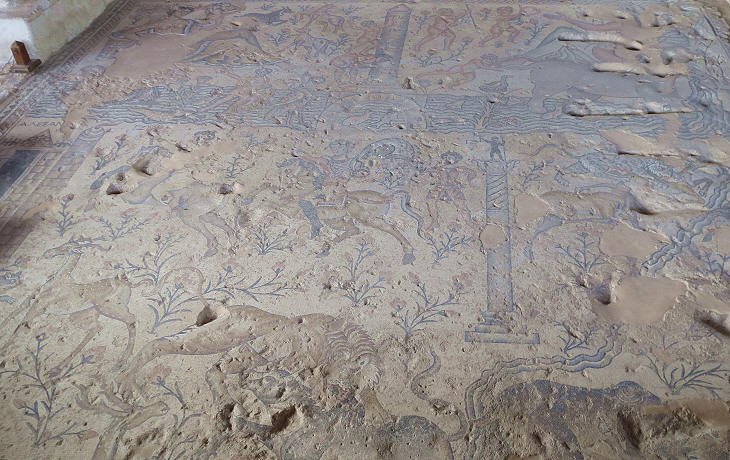
House of the Nile Mosaic - main hall
The excavations have unearthed a series of houses which were decorated with very interesting floor mosaics; they show the influence of two different schools which developed in Egypt and in Syria. The former positioned the subjects of mosaic in a landscape background which represented the River Nile (see a grand Nilotic mosaic in Italy). The latter placed the subjects inside an overall geometric frame which was in turn divided into smaller areas by decorative bands (see a mosaic from Baalbek).
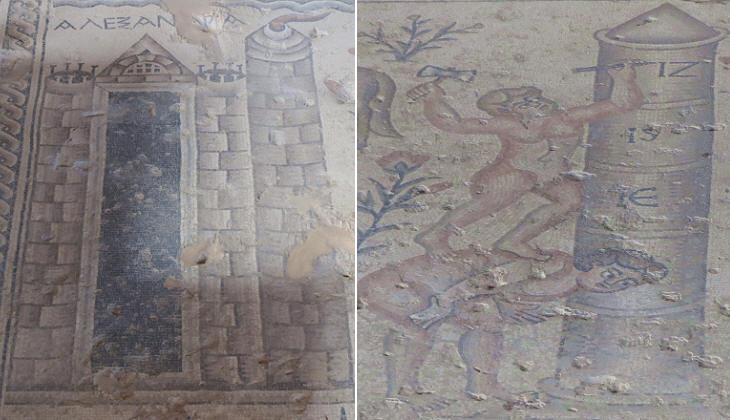
House of the Nile Mosaic - main hall: (left) Alexandria with its Lighthouse; (right) Nilometer, a structure for measuring Nile's water level
The overall subject of the mosaic is the Festival of the Nile, a series of ceremonies which took place to celebrate the periodical inundation of Lower Egypt. A boy happily mounted on another one marks the level reached by the water. A similar mosaic can be seen at the Church of the Multiplication of the Loaves and Fishes near Tiberias.
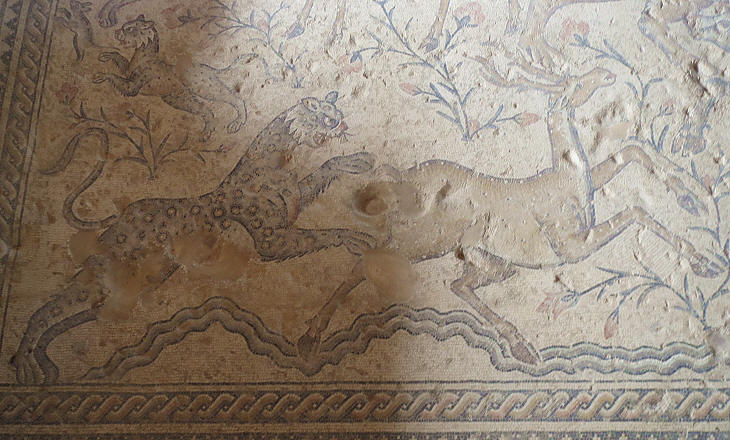
House of the Nile Mosaic - main hall: hunting scene
Hunting scenes were popular subjects in both types of mosaics: they could involve ferocious beasts such as crocodiles, lions, bears, tigers, panthers, etc. and their fleeing prey such as donkeys, deer, gazelles. etc. But in other scenes the chaser was chased and hunters with their hounds killed the beasts. In some Nilotic mosaics the hunters were pygmies. You may wish to see some mosaics depicting the trade of wild animals in Sicily.
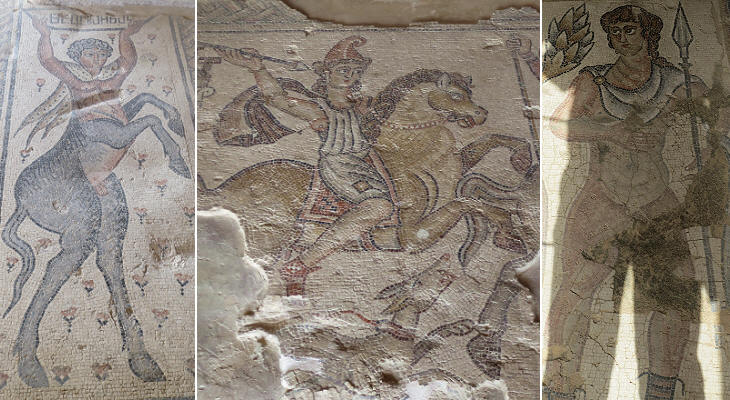
House of the Nile Mosaic: other rooms
The lavish decoration of the House of the Nile Mosaic which is located east of Cardo suggests it was the residence of a high officer. He must have been very Hellenized from a cultural viewpoint because the other rooms were decorated with subjects from the Greek myths such as centaurs, amazons and naked warriors, probably representing popular heroes.
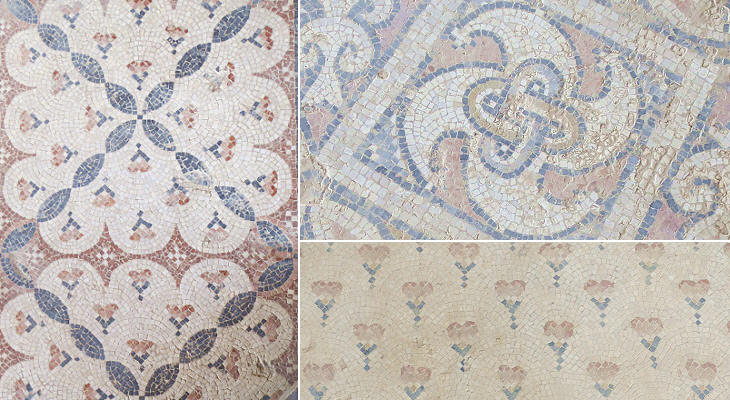
House of the Nile Mosaic: decorative patterns
Cartoons depicting different types of decorative patterns circulated among the teams of mosaic makers. You may wish to compare the Solomon's knot shown above (upper right corner) with that found at a synagogue at Sardis in Turkey and with decorative patterns in a Roman house at Brescia. The small flowers can be seen also in Lebanon.
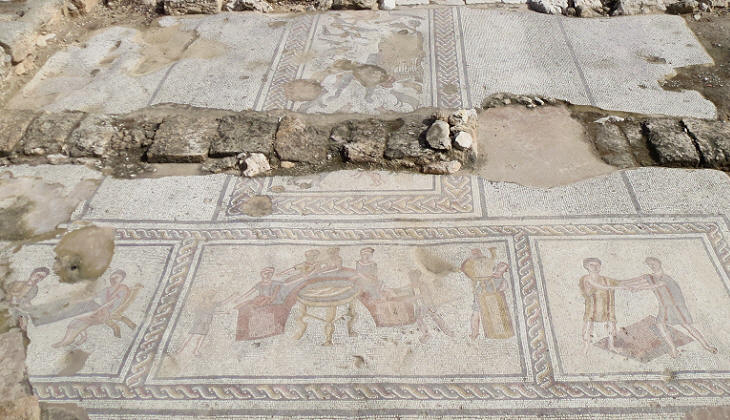
Mosaic portraying Orpheus (above) and (below from left to right) dice players, a dinner and two wrestlers about to start their fight
A mosaic of the IIIrd century AD having at its centre Orpheus taming the animals has attracted the attention of Jewish scholars who see a link between him and the biblical image of King David. Orpheus was a preferred subject of mosaics and small sculptures because it allowed the depiction of an entire zoo as you can see in a better preserved mosaic at Philippopolis in Syria. The scene of the dice players appears in a mosaic found at Thysdrus in Tunisia. The people dining are reclining on the typical Roman couches and the two wrestlers are about to engage in a fight, so the overall content of the mosaic is indication of a very Hellenized culture.
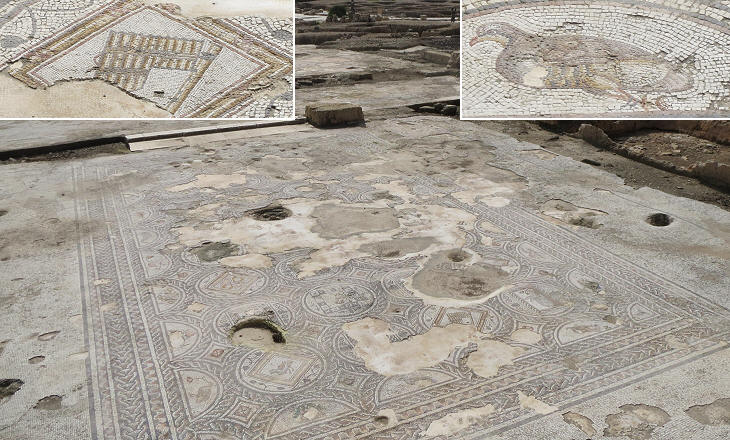
Large traditional mosaic for a reception room; (insets) enlargement of some "xenia"
Wealthy Romans showed their hospitality by decorating their reception rooms with a mosaic where items such as edible things or objects related to entertainment were depicted. They are called xenia which meant hospitality in Greek and more generally presents in Latin. You may wish to see the striking floor mosaic which decorated Horti Serviliani in Rome.
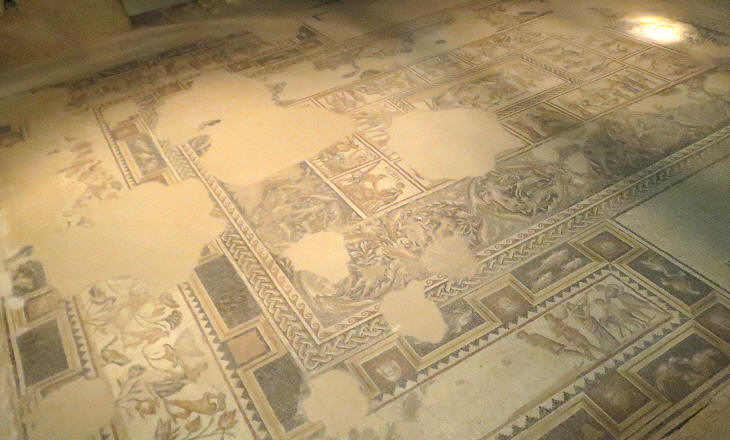
House of Dionysus (in the upper right corner the detail which is given more light)
Very near the fortress archaeologists have found a large house which they have named after its main mosaic which portrays the Greek god Dionysus, another common subject of mosaics. Unfortunately the hall built to preserve the mosaic has a lighting system which gives enough light only to a detail of it.
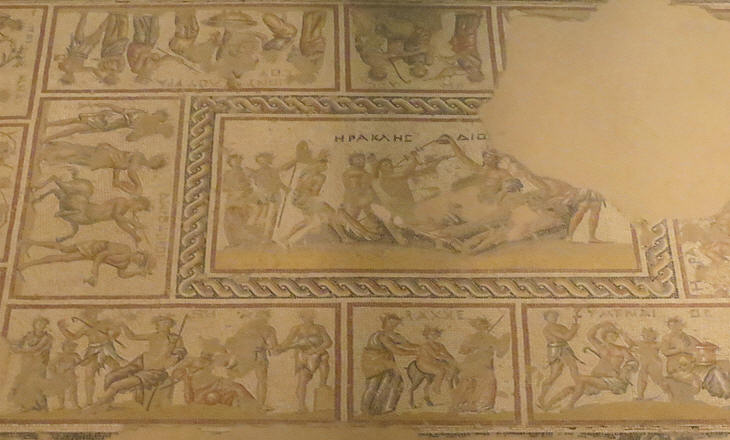
House of Dionysus: scenes of feasts and processions
The fact that Dionysus was chosen for decorating so many dining rooms is not due to strong religious feelings, but because he was the inventor of wine and his cult was associated with feasts and enjoyment. Although he was not one of the original twelve Olympian gods he was worshipped all over the Roman Empire. You may wish to see mosaics portraying Dionysus at Antioch, at Paphos (Cyprus) and in Tunisia.
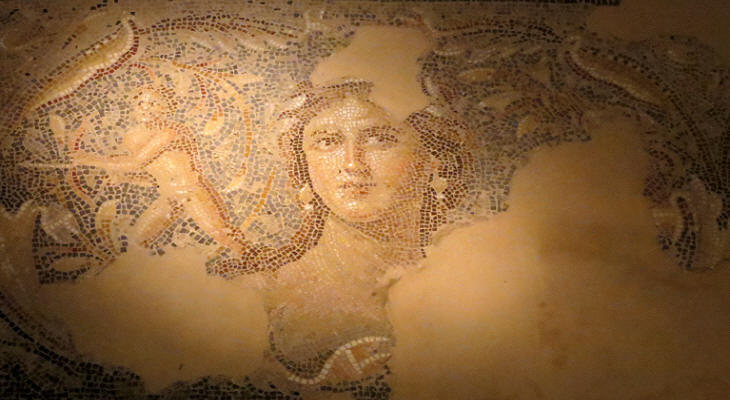
House of Dionysus: the "Mona Lisa" of Galilee
The detail for which the rest of the mosaic is kept in the dark is no doubt extremely fine; it most likely portrays Venus. You may wish to see the Zeugma Mona Lisa at Gaziantep.
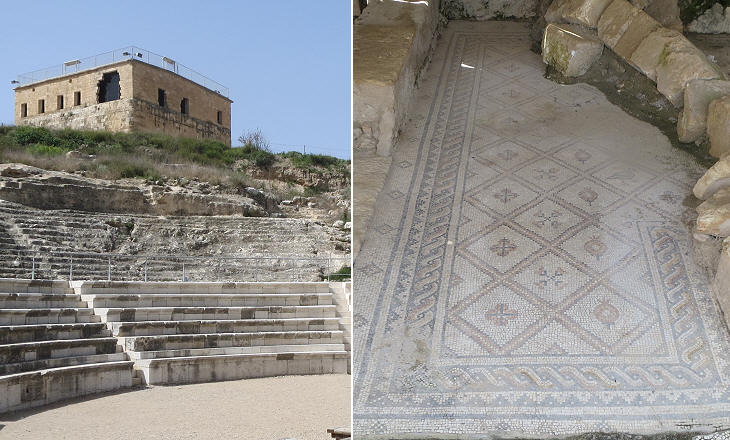
Theatre and nearby mosaic
Diocaesarea had a small theatre partly excavated into the slope of the hill. In this part of the town excavations are unearthing other mosaics and not far from the theatre a synagogue with a very interesting mosaic was found.
The image used as background for this page shows a detail of the Nile Mosaic.
You may wish to visit Volubilis, a town at the other end of the Roman Empire, which retains some houses with very fine floor mosaics.